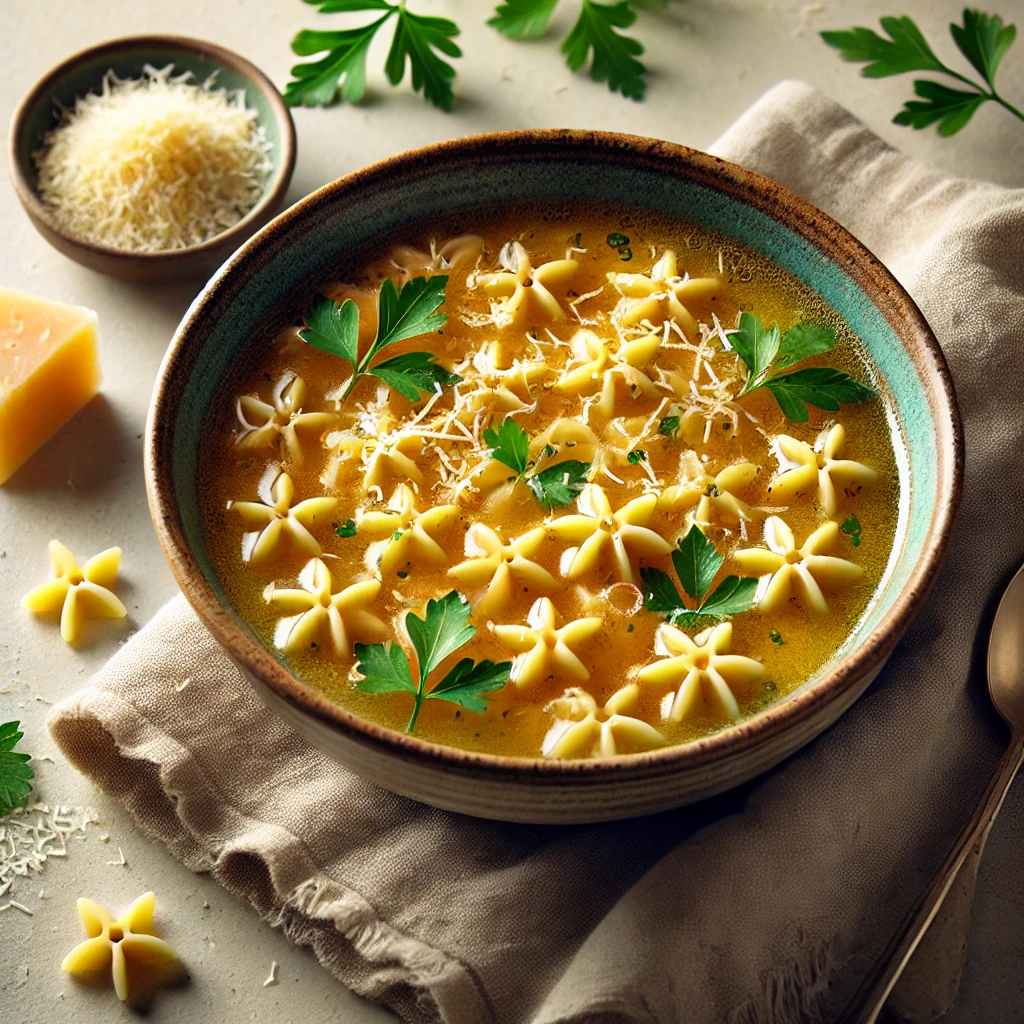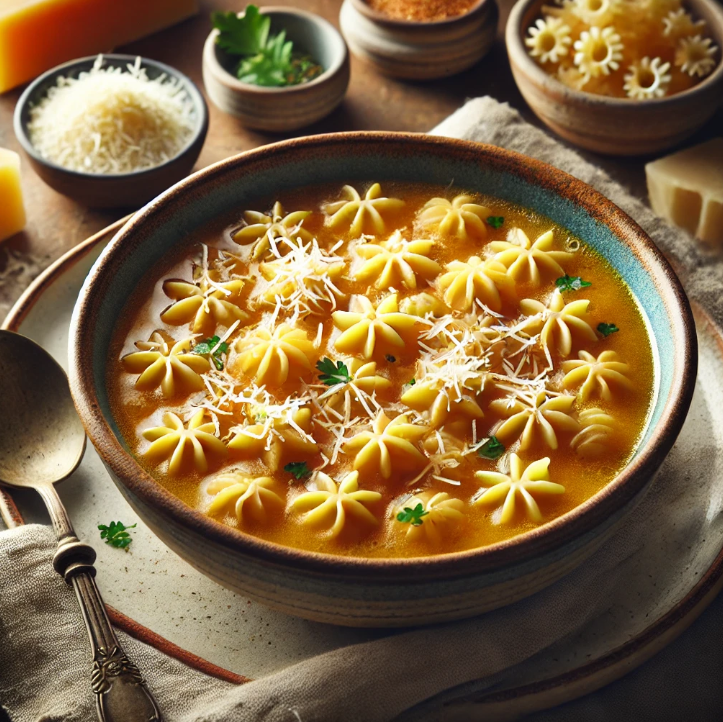Sometimes, all you need is a bowl of something warm and simple to lift your spirits, and Pastina Soup does just that. Known as “Italian penicillin,” this humble yet nourishing dish has been a staple in Italian kitchens for generations. With its tender, star-shaped pasta, flavorful broth, and a touch of butter or cheese, it’s the ultimate comfort food for all ages.
In this article, we’ll explore the story of Pastina Soup, how to make it from scratch, variations to suit every taste, and tips for serving it with flair. Whether it’s your first time trying it or a beloved childhood memory, you’ll discover why this dish remains a cherished classic.
Table of Contents
What Is Pastina Soup?
Definition and Cultural Significance
Pastina Soup is a traditional Italian dish that combines tiny pasta (commonly referred to as “pastina”) with a savory broth, often enhanced with butter or cheese. It’s more than just a meal—it’s a symbol of comfort and care, frequently served to children or those feeling under the weather. Often compared to chicken noodle soup in the U.S., Pastina Soup offers a similar sense of warmth and nourishment.
In Italian households, it’s lovingly called “Italian penicillin,” a nod to its reputation for being a cure-all during cold or flu season. Despite its simplicity, this dish holds a special place in the hearts of Italians, evoking feelings of nostalgia and home.
The Key Ingredients of Pastina Soup
The beauty of Pastina Soup lies in its simplicity. The primary ingredients include:
- Pastina Pasta: Tiny star-shaped or round pasta, often made with semolina.
- Broth: Homemade chicken or vegetable stock is ideal for its depth of flavor.
- Butter or Olive Oil: Adds a silky richness to the soup.
- Cheese: Grated Parmesan or Pecorino Romano is commonly sprinkled on top.
Optional additions like shredded chicken or diced vegetables can elevate the dish while keeping its classic essence.
Why It’s a Comfort Food Favorite
What makes Pastina Soup so beloved is its ability to provide comfort with minimal effort. The tender pasta and warm broth create a soothing combination that feels like a hug in a bowl. Its mild, familiar flavors appeal to both children and adults, making it a go-to dish for families. Whether you’re sick, tired, or simply craving something cozy, Pastina Soup never disappoints.
The History of Pastina Soup
Pastina’s Origins in Italian Cuisine
The story of Pastina Soup begins in Italy, where food has always been about simplicity and fresh ingredients. “Pastina,” which translates to “little pasta,” was first made with durum wheat semolina, a staple in Italian kitchens for centuries. Its small size and quick cooking time made it a favorite for creating light, nourishing dishes, particularly for young children and the elderly.
As families passed down their recipes, Pastina Soup became a symbol of care and love. It was often served as a first food for babies or a healing meal during sickness, earning its reputation as a trusted comfort food. Over time, this humble dish became a cherished part of Italy’s culinary heritage, celebrated for its ability to bring people together around the table.
Pastina Soup Across Generations
One of the reasons Pastina Soup has endured is its adaptability. Italian grandmothers, or nonnas, have long personalized the recipe based on what they had on hand. Some added a dash of nutmeg, others mixed in a beaten egg for extra creaminess, and many swore by freshly grated Parmesan to finish it off.
As Italians migrated across the globe, they brought Pastina Soup with them. The dish quickly became a favorite in Italian-American households, where it continues to be a nostalgic reminder of family traditions. Today, it remains a classic comfort food, bridging the gap between generations and cultures.
How to Make the Perfect Pastina Soup
Essential Ingredients for Traditional Pastina Soup
To make the perfect Pastina Soup, you’ll need just a handful of basic ingredients:
- Pastina Pasta: The star of the dish, available in shapes like stars, orzo, or tiny shells.
- Chicken or Vegetable Broth: Homemade stock adds the best flavor, but store-bought works in a pinch.
- Butter or Olive Oil: Adds a creamy texture and depth of flavor.
- Grated Cheese: Parmesan or Pecorino Romano for a savory finish.
- Salt and Pepper: Essential for seasoning the broth to perfection.
Optional additions include shredded chicken, diced vegetables, or a sprinkle of fresh herbs like parsley.
Step-by-Step Cooking Instructions
- Prepare the Broth:
In a medium pot, bring your chicken or vegetable broth to a gentle boil. Season with salt and pepper, tasting as you go. - Cook the Pasta:
Add the pastina pasta directly into the boiling broth. Stir frequently to prevent clumping and cook for 4–5 minutes, or until tender. - Add the Finishing Touches:
Reduce the heat to low and stir in a knob of butter or a drizzle of olive oil. For extra creaminess, whisk in a beaten egg, stirring constantly to avoid curdling. - Serve and Garnish:
Ladle the soup into bowls, top with grated Parmesan, and garnish with a pinch of parsley or a drizzle of olive oil. Serve immediately for the best flavor.
Tips for Adding Flavor
- Use roasted garlic in the broth for a richer taste.
- Add shredded rotisserie chicken for a protein boost.
- For a hint of brightness, squeeze fresh lemon juice over the soup before serving.
Popular Variations
Creamy Pastina Soup
For a richer, more indulgent take on Pastina Soup, try the creamy variation. Add a splash of heavy cream or milk to the broth before simmering the pasta. This creates a thicker, velvety texture that feels luxurious while still maintaining the dish’s simplicity. Top it off with extra Parmesan for a bold, cheesy flavor.
Vegetarian Pastina Soup
To make Pastina Soup vegetarian, swap chicken broth for vegetable stock. Enhance the flavor by adding finely chopped carrots, celery, and leeks. A squeeze of lemon can brighten the dish, and a handful of spinach or kale stirred in at the end adds color and nutrition. This variation is perfect for those who prefer a lighter, plant-based meal.
Cheesy Pastina Soup
Cheese lovers will adore a fully loaded cheesy version of Pastina Soup. Along with Parmesan, consider mixing in sharp cheddar or mozzarella for added creaminess. Stir the cheese directly into the broth for a smooth, melty consistency. For extra flair, sprinkle breadcrumbs on top and broil the dish until golden brown.
For more inspiration, check out more recipes on Recipes to Explore .
Common Mistakes to Avoid
Overcooking the Pasta
It relies on the tender texture of its tiny pasta, so overcooking can quickly turn it mushy. Keep a close eye on the cooking time—pastina only takes a few minutes to reach perfection. Remember to stir frequently to prevent clumping.
Using Low-Quality Broth
Since broth forms the base of Pastina Soup, its quality makes a significant difference. Avoid using overly salty or bland store-bought broths. Whenever possible, opt for homemade chicken or vegetable stock for a richer, more complex flavor.
Skipping the Butter or Cheese
Butter and cheese are not just optional—they’re essential for achieving the dish’s signature creamy richness. Skipping these ingredients can result in a soup that feels incomplete. Always finish with a generous sprinkle of Parmesan for that comforting, savory taste.
Serving Suggestions
Pairing with Side Dishes
It is a comforting dish that pairs beautifully with a variety of sides. For a light and balanced meal, serve it alongside a fresh garden salad with a zesty vinaigrette. Garlic bread or warm, crusty rolls are excellent for soaking up the flavorful broth, adding a hearty element to the dish. If you’re hosting a meal, consider offering roasted vegetables, like carrots or zucchini, to complement the soup’s simple, nourishing flavors.
Garnishing Tips
A well-chosen garnish can elevate the presentation and taste of Pastina Soup. Sprinkle freshly chopped parsley or basil on top for a pop of color and a hint of freshness. A drizzle of olive oil adds a silky finish, while cracked black pepper gives a little extra bite. For a richer experience, top each bowl with additional grated Parmesan cheese or a dollop of ricotta.
For a sweeter comfort dish, consider trying this Sweet Potato and Apple Casserole.
FAQs About Pastina Soup
What Is It Made Of?
It features just a few simple ingredients: tiny pasta, savory broth, butter, and grated cheese. Optional ingredients like shredded chicken or fresh vegetables can be added to make the dish heartier.
Can It Be Made Gluten-Free?
Absolutely! Gluten-free pastina or other small pasta shapes made from rice or corn work perfectly. Be sure to use a gluten-free broth to keep the dish safe for those with gluten sensitivities.
How Do You Store and Reheat It?
To store leftovers, transfer Pastina Soup to an airtight container and refrigerate for up to 3 days. When reheating, add a splash of broth or water to prevent the pasta from absorbing all the liquid and becoming overly thick. Warm it gently on the stove or in the microwave, stirring frequently.
Is It Good for Kids?
Yes! With its mild flavor and soft texture, It is a kid-friendly meal that’s easy to eat and digest. It’s a great option for picky eaters or as a comforting dish for little ones feeling under the weather.
Final Thoughts on Pastina Soup
Why Pastina Soup Stands the Test of Time
There’s a reason why it has remained a beloved dish across generations—it’s the ultimate comfort food. Its simplicity, paired with its soothing flavors, makes it a timeless classic. Whether you’re making it to warm up on a chilly evening or as a remedy for a cold, this dish always hits the spot. Its versatility is another reason it endures; you can stick to the basics or get creative with variations to suit any palate.
Beyond its comforting taste, it carries a sense of nostalgia. For many, it brings back memories of childhood, sitting at the table with a steaming bowl made lovingly by a parent or grandparent. That emotional connection makes it so much more than just another soup.
Encouraging Personalization
One of the best things about it is how easy it is to make it your own. Experiment with different broths, cheeses, and toppings to create a version that’s uniquely yours. Add a pinch of your favorite spice, or incorporate fresh herbs from your garden. The possibilities are endless, and each variation brings something special to the table. So, whether you’re recreating a family recipe or starting a new tradition, it is a dish worth celebrating.
For more inspiration on simple yet satisfying meals, explore this Easy Wor Wonton Soup Recipe.
Bonus Recipe Variations for Pastina Soup
Classic Egg Drop Pastina Soup
For an extra touch of creaminess, turn it into an Italian-style egg drop soup. Whisk a fresh egg and drizzle it slowly into the hot broth while stirring gently. The egg cooks instantly, creating silky ribbons that add both texture and flavor.
Lemon Herb Pastina Soup
Brighten up your bowl with a squeeze of fresh lemon juice and a handful of chopped dill or parsley. This variation is light, refreshing, and perfect for springtime. The citrus tang pairs beautifully with the savory broth, offering a new twist on the classic.
Cheesy Vegetable Pastina Soup
Take Pastina Soup to the next level by adding diced carrots, celery, and spinach. Simmer the veggies in the broth before adding the pasta, then stir in shredded mozzarella or cheddar for a hearty, cheesy upgrade.
For more comforting recipes and creative twists on Pastina Soup, visit Allrecipes. Their extensive collection of easy-to-follow recipes will inspire you to bring this classic Italian favorite to life in your own kitchen!



2 thoughts on “Pastina Soup: A Comforting Italian Classic”